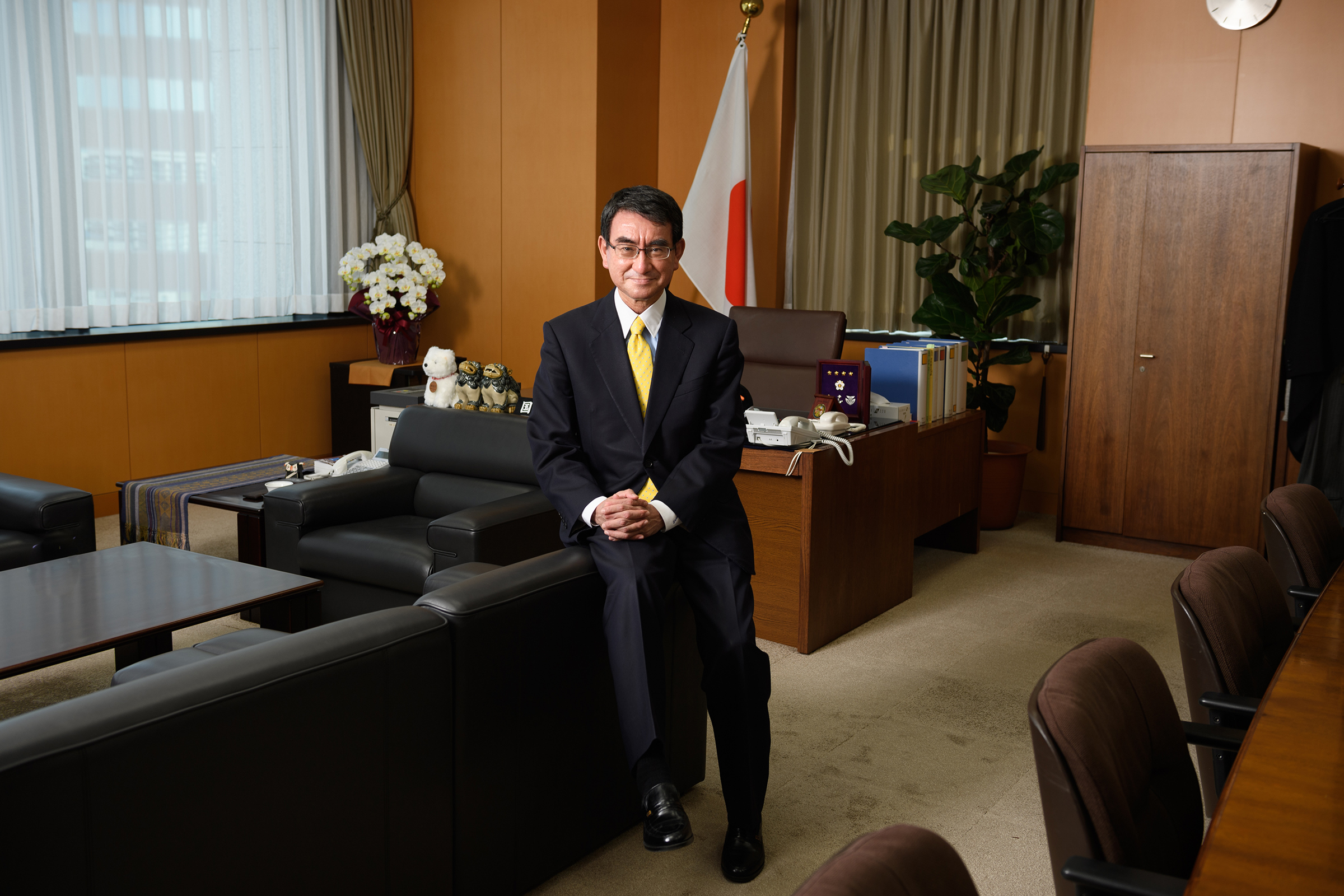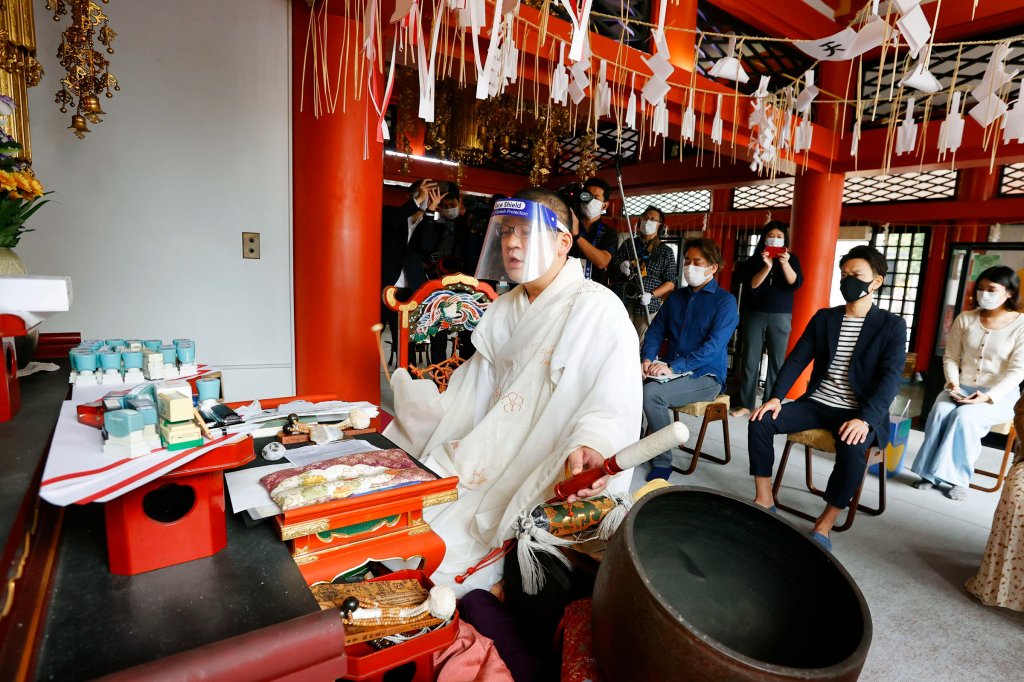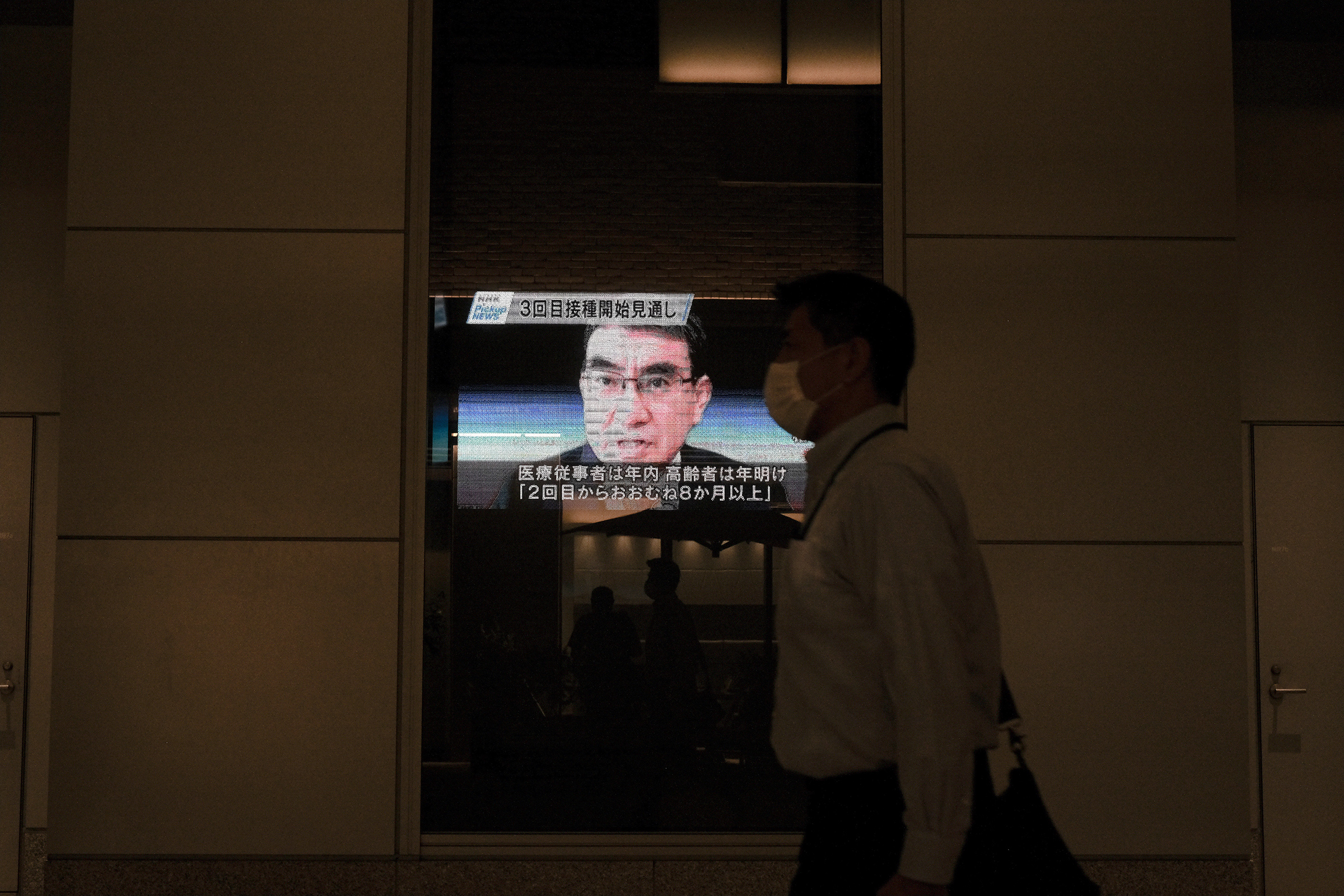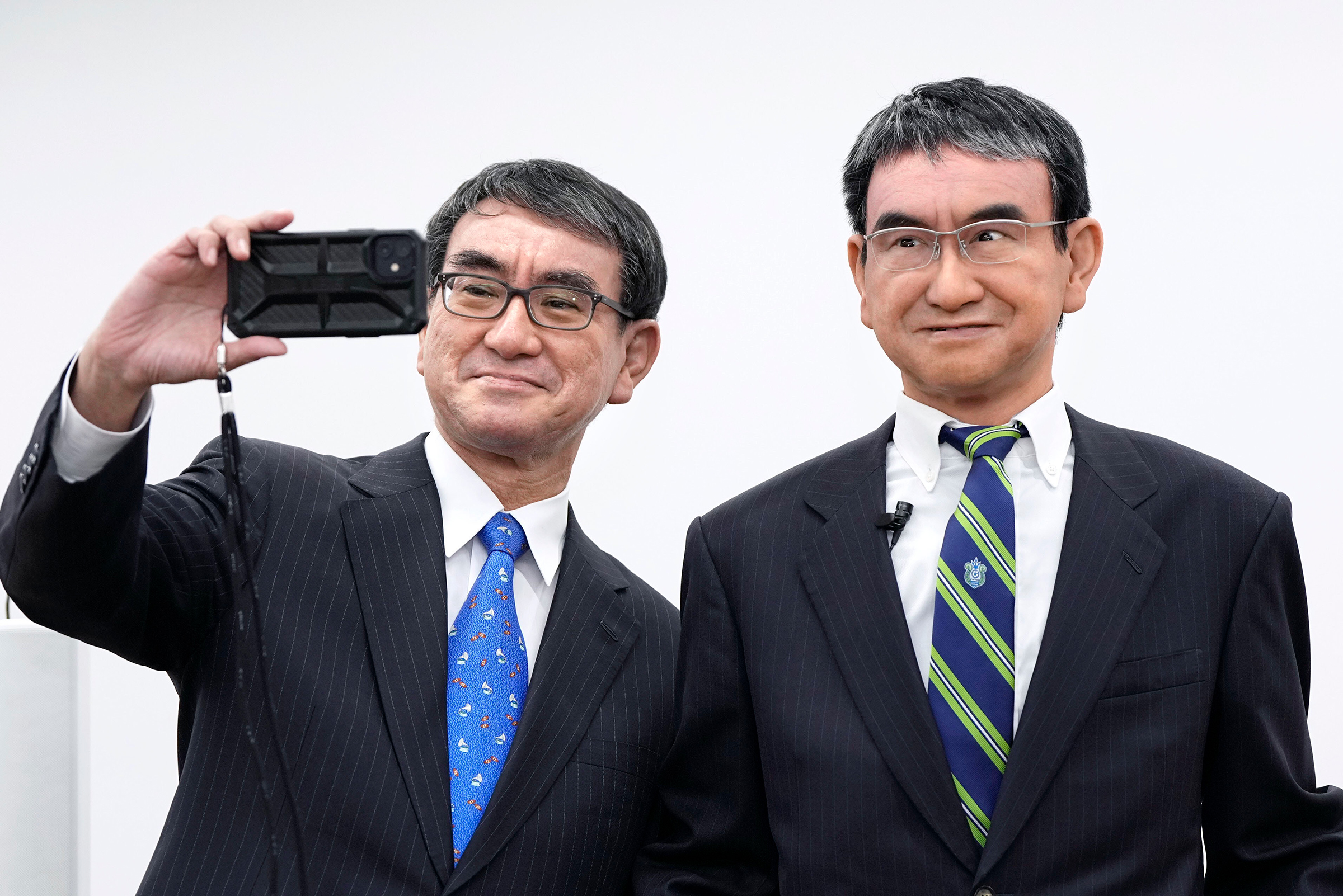While the West romanticizes Japan as an arcane futurescape, a neon-swathed land of bullet trains and buzzing toilets, in truth the world’s No. 3 economy struggles with a deep resistance to change and a fetishism of archaic bureaucracy. But Taro Kono, the country’s 60-year-old Digital Minister, is on a mission to bring Japan’s reality bit by bit closer to its oft-perceived modernistic image.
Kono may have his own lifesize mechanical avatar designed by a professor at Osaka University—“I’m hoping to use it to let people know about the new national ID card we’re issuing,” he says—though today his homeland lags badly when it comes to digitalization. Hence, he is only too happy to strike a small blow against staid etiquette by jumping on a Zoom interview.
“Japan was quite good with analogue technology,” says Kono, who has previously served as Foreign Minister and Defense Minister. “But when things moved to digital, we were too content with analogue things, so we didn’t invest enough.”

According to Kono, Japan’s huge government deficit—public debt to GDP stands at 256%, the highest in the world and double that of the U.S.—has over recent years made its Finance Ministry too strict with the government purse strings; it simply won’t fund departments to upgrade their systems. That means the private sector hasn’t been able to upgrade either, he says, “because they have to be compatible with the government.”
Kono’s ministry has found 9,000 government regulations that still require handling via antiquated technology, including faxes, floppy disks and the hanko—a carved stamp that is obligatory for many official documents. “We just found one clause saying you have to submit a photograph on color film,” he says with patent exasperation.
More from TIME
Kono’s goal is to peel back these antiquated foibles and drag Japan into the 21st century. His agency has a sprawling remit to streamline processes that currently require pen and paper into sleek digital equivalents, whether for paying taxes or applying for planning permission. Still, it’s an uphill task. Kono highlights that Singapore has 3,500 people working in its digital agency to serve a population of 5.5 million; Kono has 800 staff for 125 million. “Some of them are only part-time because we cannot afford to pay a full salary,” he says. “So we’re definitely desperately understaffed, but we need to do what we can.”
The scale of the problem was underscored by the pandemic, during which Kono served as minister for vaccine rollout. “Our health ministry seriously tried to count paper to know how many vaccines we administered the day before,” he says. “So I had to develop a new system to keep track of vaccines in two months.”


Meanwhile, a plan to provide 100,000 yen ($750) COVID grants to every citizen stumbled due to a lack of digital records. Instead, a form was sent to every household asking for the occupants’ bank details. It took about six months before anyone saw their money. For Kono, the pandemic exposed “how bad government systems are.”
Kono’s fluent English sets him apart from your typical Japanese official, while his penchant for suspenders and carrying a small steel-plated cream and purple briefcase—whose mysterious contents is a topic of some conjecture amongst policy wonks—engenders an image as a lovable eccentric.
It’s a breath of fresh air that charms voters and sees Kono consistently rank as Japan’s most popular politician. At the same time, it has alienated elders of the ruling Liberal Democratic Party (LDP), which chose the dour Fumio Kishida to replace Yoshihide Suga as Prime Minister in October 2021, despite Kono having twice the popular support. Ultimately, Kono’s political ambitions founder on a nigh pathological inability to toe the party line. Kono favors marriage equality and actively opposes nuclear power—both strikingly at odds with LDP orthodoxy.
“He’s a really smart, articulate, talented politician, which are not thick on the ground here,” says Jeffery Kingston, director of Asian Studies at Tokyo’s Temple University Japan. “So the people like him a lot. But the problem is that he is widely disliked within the party.”
It was Kono’s time overseas that shaped his values and character. After dropping out of university in his homeland, Kono studied at Georgetown and later worked on Alan Cranston’s unsuccessful campaign to be the Democratic nominee in the 1984 U.S presidential election. He then went to Poland when it was still a Soviet vassal, spending a night in prison after visiting the leader of the anti-authoritarian Solidarity workers’ movement. On his return, he spent a decade in business before getting elected as a LDP lawmaker for a constituency south of Tokyo in 1996. Kono says going abroad “opened up my eyes so I could see Japan in an objective way.”

But despite his quirky demeanor, Kono is no political neophyte; his father, Yohei Kono, was an LDP president and a Deputy Prime Minister. When, in 2002, his father fell ill from a chronic hepatitis C infection, Kono provided a portion of his own liver for his treatment and subsequently lobbied for changes to laws governing organ donation.
And while he loves taking on the establishment, he’s very much an iconoclast, whose use of humor in official settings is also a rarity in Japan’s beige officialdom. His favorite medium is Twitter—his Japanese account has 2.6 million followers and his English-language one over 70,000—where he chastises civil servants for excessive hours and lampoons Japan’s sacrosanct work culture. “There is no analogue thing left in our remarkably advanced society. Oops, my fax machine is jamming!” he once tweeted. To TIME, he calls Twitter his “killing time” escape.
Kono’s portfolio tells a wider story of the effort to modernize Japan. While the nation boasts the world’s longest life expectancy, lowest murder rate, and unruffled political transitions, it also suffers torpid growth, and its shrinking, graying population is an unprecedented demographic time bomb. Every year, Japan loses half a million people, and today the country sells more adult diapers than infant ones. Other than boosting efficiencies through digitalization, reforms are underway to raise the productivity of women and seniors and attract more overseas talent.
“There is an acute labor shortage in some industries,” says Kono. “One way is to attract foreign workers. Right now, for certain segments, I think Japan is probably the easiest [place] to get a work permit.”
While today Kono rails against the lack of investment in digitalization, his previous bête noire was wasteful military spending. Soon after assuming the post of Defense Minister in 2019, he directed a broad probe of U.S. hardware purchases. In January 2020, Kono abruptly canceled the $4.2 billion U.S. Aegis Ashore missile defense system over perceived technical glitches, despite his government already sinking $2 billion into the project, prompting complaints from his fellow lawmakers about a lack of proper consultation.

Today, though, Japan is undergoing a thorough military overhaul—doubling defense spending to 2% of GDP, which brings it into line with NATO guidelines and propels it to be the world’s third-biggest defense spender after the U.S. and China. In a move that critics say violates its pacifist constitution, Japan is also acquiring new weapons that can strike enemy targets 1,000km away with land or sea-launched missiles.
Kono backs the upgrades given the raised threat posed by Russia’s invasion of Ukraine, as well as the perennial menace of North Korea and China’s new assertiveness under strongman Xi Jinping. He highlights how Beijing’s military spending has nearly tripled in the last decade, with Chinese ships “violating our territorial water almost every day,” he says.
“When we invited China to join the WTO, although they have a different political system, [we thought] if they became a good player in the global economy, everyone would benefit,” he says. “Unfortunately, things haven’t turned out that way.”
Of course, it’s not a challenge that Japan is undertaking alone. Over the last few months, the Kishida administration has enhanced its cooperation with the U.S. and regional allies like Australia, South Korea, and India, and it’s preparing to welcome the G7 grouping to Hiroshima. “It’s quite obvious, looking at Ukraine, that the alliance with the United States is never more important,” Kono says. And “I’m hoping that maybe AUKUS could one day become JAUKUS,” he adds with a wry smile, “and the Five Eyes [intelligence network] could become the Six Eyes—or five eyes and a wink.”
Some of these issues may be beyond the scope of Kono’s current role, but he’s keenly interested in the direction of the country as a whole. As for his ambitions for Japan’s top job? “Well, you never know, right?” Kono says with a grin. “We’ll see.”
More Must-Reads From TIME
- The 100 Most Influential People of 2024
- The Revolution of Yulia Navalnaya
- 6 Compliments That Land Every Time
- What's the Deal With the Bitcoin Halving?
- If You're Dating Right Now , You're Brave: Column
- The AI That Could Heal a Divided Internet
- Fallout Is a Brilliant Model for the Future of Video Game Adaptations
- Want Weekly Recs on What to Watch, Read, and More? Sign Up for Worth Your Time
Write to Charlie Campbell at charlie.campbell@time.com
